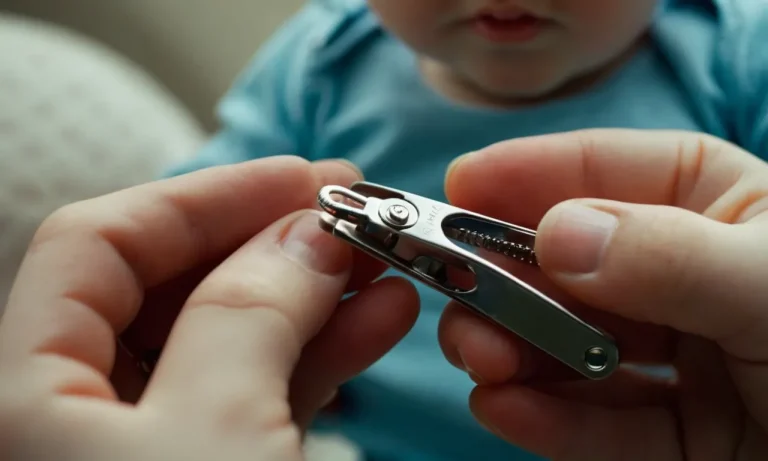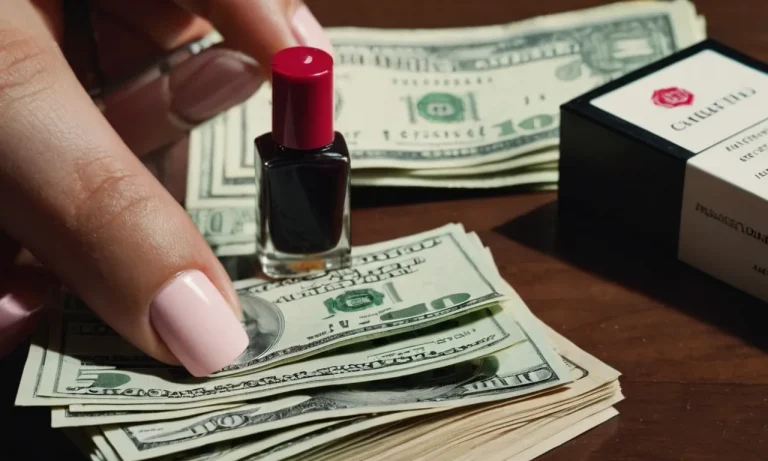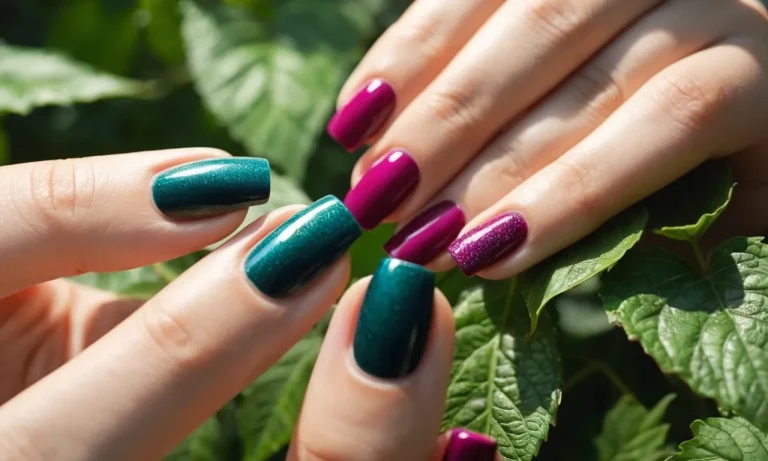How To Wear Fake Nails Without Damaging Your Real Nails
Fake nails have become a popular way to get beautiful nails instantly. But if you’re not careful, wearing press-on or acrylics can seriously damage your natural nails over time. Luckily, there are steps you can take to wear fake nails safely without causing harm.
If you’re short on time, here’s the quick answer to keeping your real nails healthy under fake ones: Prep your nails properly, use nail glue instead of acrylic or glue tabs for press-ons, avoid excessively long or heavy styles, and give your natural nails a break in between wears.
Properly Prep Your Natural Nails
Remove Old Nail Polish
Before applying fake nails, it’s crucial to start with a clean slate by removing any old nail polish from your natural nails. Use an acetone-based nail polish remover and cotton balls to gently remove all traces of color. Don’t pick or peel off old polish, as this can damage the nail bed.
Take your time with this step to avoid weakening your natural nails.
File and Shape Your Nails
Once your natural nails are clean, use a nail file to shape them. File in one direction starting from the outside edges and moving toward the center to prevent breakage. Shape the nails to your desired length and file away any rough edges or peeling layers for a smooth surface.
This allows the fake nails to adhere better with no bumps. An even shape on your natural nails helps the fake ones look more natural.
Use a Dehydrator and Primer
Before applying fake nails, it’s important to thoroughly dehydrate the natural nails so the glue adheres well. Use a nail dehydrator or rubbing alcohol on a cotton pad to remove all moisture and oils from the nail plate.
Let your nails dry completely, then apply a nail primer to help the glue bond properly. The primer fills in any crevices on the nails and allows even adhesion across the whole surface. Prepping with a dehydrator and primer helps the fake nails last longer without lifting or damage to your real nails underneath.
Choose Your Fake Nail Type Wisely
Press-On Nails
Press-on nails are a quick, easy way to get a beautiful manicure in minutes. They come ready to wear with adhesive tabs or glue on the underside. Simply remove the adhesive backing, place the nails on your fingertips, and press to adhere them.
Press-ons are available in different lengths and designs to suit your style. They are an affordable option that can be reused a few times if removed gently.
The main benefit of press-on nails is their convenience – you can apply a flawless manicure in the comfort of your own home in just minutes! No need for harsh chemicals or drying time. However, press-ons may not last as long as other artificial nail options.
The adhesive can wear off in a few days, especially if you are hard on your hands. Pressing down firmly when applying and avoiding water exposure can help extend wear.
Acrylics
Acrylic nails are applied by a professional nail technician using a liquid and powder polymer that is shaped on a form over your natural nail. The mixture hardens to create an extension over your real nail. Acrylics allow you to get long, customized nail shapes and designs.
The application process takes around an hour and fills help extend wear to 2-3 weeks on average.
A major benefit of acrylics is the ability to create any length and shape you desire. They are very strong and durable. However, acrylics do require professional application and removal to avoid damage, which adds time and expense.
The chemicals used can also dry out the natural nails if done repeatedly. Proper hydration and nail oil are recommended to counteract this.
Gel Manicure
Gel manicures gained popularity for their extended wear and chip-free shine. They are painted on like regular nail polish but cured under an LED or UV light. Gels come in endless colors and finishes to match any style.
Application takes about 30 minutes at a salon and can last up to 3 weeks with proper care.
The glossy finish of gel manicures makes them visually appealing and the durability is greater than regular polish. However, gels do require curing under lights which can weaken or dry out the natural nails over time. Using nourishing treatments in between applications helps reduce damage.
Removal must be done properly as well to avoid pulling off layers of the natural nail.
When selecting artificial nails, consider the application time, longevity, and impact on your real nails. Press-ons are quick but temporary. Acrylics and gels require more of an investment but allow greater customization and wear.
No matter which you choose, nurture your real nails with moisture to keep them healthy under any faux manicure!
Apply and Remove Fake Nails Correctly
Use Nail Glue for Press-Ons
When applying press-on fake nails, avoid using tapes or sticky tabs as these can damage the nail bed. Instead, use a small drop of nail glue specifically designed for press-ons. Applying a thin layer of glue helps the fakes adhere properly without tugging on the real nail when removed.
Let the glue set for 30-60 seconds before pressing on the nail tip.
Avoid Picking at Nails
Once your fabulous fakes are on, resist the urge to pick at them! Picking causes lifts and cracks which allow moisture underneath leading to possible fungus or infection. If you notice a lift, gently press the nail back into place and add a small drop of glue. And don’t peel off fakes like a sticker!
Slide dental floss under the tip and gently roll side-to-side to loosen the bond instead.
Soak Off Gently with Acetone
When it’s time for a new nail look, properly remove fake tips to avoid real nail damage. Skip ripping or picking, which can pull off layers of natural nails. Rather, soak cotton balls in 100% acetone nail polish remover and place them gently under each tip for 10-15 minutes.
The acetone will dissolve the glue so fakes slide right off, according to nail care brand Essie. Follow with cuticle oil to hydrate nails.
Maintain Healthy Natural Nails
Keep Nails Shorter
Keeping your natural nails trimmed shorter is one of the best ways to prevent damage when wearing fake nails. Longer natural nails are more likely to bend and break under the weight and pressure of fake nail extensions.
Aim to keep your nails filed to just beyond the fingertip, ideally no longer than 1⁄4 inch past the end of your finger. This provides a strong, sturdy foundation for gluing on fake nails. Shorter nails are less likely to get caught on things and break.
They also distribute the weight of fake nails across all your fingers more evenly.
Use Strengthening Treatments
Using nail treatments that strengthen and reinforce your natural nails is highly recommended if you regularly wear fake nails. Look for products containing hydrating ingredients like Vitamin E, jojoba oil, or shea butter. You can find nail strengthening polishes or overnight treatments.
An excellent option is applying a base coat containing calcium or vitamins before gluing on fake nails – this helps protect the nail while wearing extensions. Taking oral supplements with biotin, vitamin D, keratin, or collagen can also improve nail health and strength over time.
Keeping your nails moisturized and nutrient-rich makes them more resilient against any damage from acrylics or glue.
Take Breaks Between Wears
Giving your natural nails a break between wearing fake nails is crucial. The American Academy of Dermatology Association recommends taking off acrylic or gel polish and avoiding enhancements for several weeks, every 2-3 months.
This allows your nails to fully recover from constant coverage and exposure to glues/chemicals. The break also gives you a chance to assess your nail health, file away lifted layers, and treat any problem areas. Your nails need time to breathe!
Rotating between wearing fake nails and having bare nails prevents excessive, ongoing damage. Listen to what your body needs and avoid overdoing fake nails if your natural nails seem thin or weak.
Know When to Avoid Fake Nails
Injured or Brittle Nails
Putting fake nails on top of injured or brittle real nails can lead to further damage. If your natural nails are peeling, cracking, or otherwise compromised, it’s best to allow them to heal before applying fake ones.
The extra weight and pressure from acrylic or glue-on nails could cause the real nail to separate from the nail bed or break. Tend to your natural nails first with moisturizing treatments until they regain strength.
Additionally, very short nails provide little surface area for gluing on fake ones. Glue-on nails rely on a tight seal with the real nail to stay in place. With not enough nail length to adhere properly, the fakes may pop off frequently. Let your natural nails grow out more before gluing on fakes.
Hangnails or Cuticles
Prepping nails with hangnails or overgrown cuticles can open you up to infections. Nail technicians often use cuticle pushers and nippers to make sure the nail plate is exposed for nail enhancements to bond properly.
If you have painful hangnails or sensitive cuticles, this process can cause redness and irritation around the nail bed. Infections could then develop underneath acrylic nails or around glued-on tips.
Before a fake nail application, remove any hangnails carefully with cuticle nippers sterilized in rubbing alcohol. Then use cuticle remover gel and gently push back cuticles. If you experience discomfort, swelling, or bleeding, postpone nails until the skin heals.
Allergic Reactions
Some people discover they have allergies to chemicals in fake nails or adhesives only after application. Acrylic nails use a liquid and powder combination containing methacrylate monomers to form extensions.
These ingredients can provoke skin redness, itching, blistering, or respiratory irritation if you have sensitivities. The glues for press-on nails may contain similar compounds plus potentially irritating cyanoacrylate.
If you’ve never worn fake nails before, test a small amount of adhesive on your arm first and watch for a reaction over 24 hours. If your skin repsonds negatively, avoid that nail product. Opt for hypoallergenic, vegan nail glues instead.
Tell your manicurist about any chemical allergies before starting acrylics or other enhancements so they can adapt products and techniques.
Conclusion
Fake nails can be damaging if you’re not careful, but taking the right precautions allows you to wear acrylic, gel, or press-on nails safely without wrecking your real nails. Properly prep and prime your natural nails, opt for shorter nail glues over acrylics, gently remove them after wear, and be sure to take breaks to keep your own nails healthy and strong.







